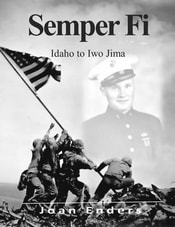
Joan taught literature and research skills in middle and high school libraries for 28 years. She was a recipient of the American Library Association’s Frances Henne Award for library leadership. She is a FamilySearch online volunteer fielding questions from directors of Family History Centers. She enjoys “peeling the research onion” for students and adults. Joan speaks to professional organizations and at genealogy conferences

About the books:
Evidence is Lacking, Yet I Still Hope by Joan Enders (2018) $24.95
Joshua Henry Bates, a young teacher in a country school, wondered what he would do with his life. He enjoyed summers away from the farm, attending the University of Utah, dancing and watching pictures shows, and ice cream on bone dry summer days. In his journal he questioned his future. He found a young woman to love, then registered for service in the American Expeditionary Forces. Readers will review primary sources about Joshua, an everyman doughboy of World War I, including documents and photographs from his youth, his journal and Camp Lewis diary and many other materials about him.

Semper Fi: Idaho to Iwo Jima by Joan Enders (2020) $19.95
His mother called him “Sunshine Boy.” He played cowboy riding the goat, Jack, around their dry farm in Idaho, stalked lions (their dog Fritz) in the field, rode fine Arabian stick horses, and picked buttercups for the best mother in the world. He didn’t realize how poor they were until a city slicker pointed it out. Graduating from high school, Lee enlisted as a Marine. This interactive book includes Lee’s photographs, his own words, and documents for the reader-detective to patch together Lee’s story, experiencing World War II, Iwo Jima, and his life on the personal level it was lived.
Alan asked Joan about her books and their popularity among people interested in researching family histories.
How would you describe your two books?
Thumbing through them, you would think they were scrapbooks. Semper Fi and Evidence is Lacking are both “deconstructed” life stories of young men serving their country. What was it like to be a World War I doughboy in the newly constructed Camp Lewis? We’ve all seen the photos of Marines on Iwo Jima, but what was it like to a private first class in the 27th Division? Both books include primary source materials (diaries, journals, photographs, official documents, newspaper clippings, written histories, etc.) that the reader-detective uses to form a historical narrative about the person. It requires that you read, sort, analyze, and research the sources to make sure the narrative is as exact as it can be, based on the material in the book.
How can the books be helpful to people who are interested in exploring their own family’s history?
Family history use was not my initial goal for the books, but the reviewer and reader comments have consistently mentioned that reading and working with the books gave them the impetus to find the same kind of sources for their ancestors.
What prompted you to create these books?
The US History teachers at RA Long High School were in mourning over my impending retirement, and at conferences, teachers would tell me there was no way they or their librarians could create such a wealth of primary source materials to analyze, so I decided to produce the first book for them. I also created a teacher resource book, and offer teacher workshops and student debriefings online.
What are the similarities and differences between them?
The formats of the books are the same. The artifacts and documents are in chronological order, and both subjects are honorable, accomplished men. W. Lee Robinson, the subject of the second book, is alive and well. A retired vice president of forestry for Fibre, he just turned 96 and is one of the most amazing persons I have met. He writes poetry for his children, grandchildren, and great grandchildren. He wrote his own life story from which I liberally quoted. Much of it is about Iwo Jima.
You volunteer with FamilySearch. What resources does the organization provide?
Do you have a day? They assist in Family Tree construction and archiving of family photographs, documents, stories, audio recordings, research materials in digital and book formats, and provide advice, assisted by more than 1000 volunteers. They also offer local Family History Centers where people can access help and online genealogy lessons and databases for free.
You can learn more about Joan’s books and Family Search on her website at www.joanenders.com.
